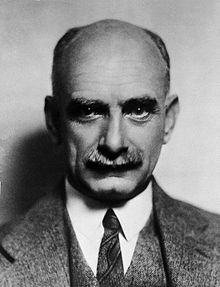Thomas Lewis (cardiologist)


Sir Thomas Lewis,
Early life and education
Lewis was born in
MBBS with the gold medal in 1905. The same year he was awarded a Doctor of Science (DSc) degree from the University of Wales
for his research work.
Career
Lewis remained at UCH for the rest of his life, beginning as a
Fellow of the Royal College of Physicians
(FRCP) in 1913.
While still a house physician, Lewis began
James MacKenzie, Lewis founded the journal Heart: A Journal for the Study of the Circulation, which he renamed Clinical Science in 1933. In 1913, he published the book Clinical Electrocardiography, the first treaty on electrocardiography. Lewis was elected a Fellow of the Royal Society (FRS) in 1918.[1]
He was promoted to full physician at UCH in 1919.


During the
Commander of the Order of the British Empire (CBE) in January 1920[15] and was knighted in the 1921 Birthday Honours.[16]
After the war, Lewis established the clinical research department at UCH and continued his work on
Raynaud's disease, and finally to the mechanism of pain, summarising his findings in Pain in 1942. His 1932 book Diseases of the Heart became a standard medical text. In 1930 he described the Hunting reaction
, alternating vasodilation and vasoconstriction of peripheral capillaries in cold environments.
In 1930, he founded the
Lord Lister
in 1902. He served as vice-president of the Royal Society from 1943 to 1945.
Lewis suffered a
coronary heart disease at his home at Loudwater, Hertfordshire
, on 17 March 1945, at age 63.
Family
Lewis married Alice Lorna Treharne James in 1916. They had three children.
Publications
- The Mechanism of the Heart Beat (1911)
- Clinical Electro-Cardiography (1913)
See also
References
Notes
- ^ Lewis personally disliked the term "cardiologist" and preferred to describe himself as a cardiovascular disease specialist.[2]
Wikimedia Commons has media related to Thomas Lewis (cardiologist).
Citations
- ^ S2CID 72220548.
- ^ Oxford Dictionary of National Biography
- PMID 18651531.
- S2CID 33093678.
- PMID 16024897.
- PMID 9068389.
- ISBN 978-3-540-76049-8.
- S2CID 22520472.
- ^ Birdsong, William T. (18 November 2010). "Sensing Muscle Ischemia: Coincident Detection of Acid and ATP via Interplay of Two Ion Channels". Neuron. 68 (4): 739–749 – via Cell Press.
- ^ "Obituary". British Medical Journal. 461 (British Medical Journal): 1. 31 March 1945. Retrieved 17 June 2015.
- ^ "The National Library of Wales :: Dictionary of Welsh Biography". The National Library of Wales. Retrieved 17 June 2015.
- ISBN 978-3540760498.
- ^ "Clifton College Register" Muirhead, J.A.O. p180: Bristol; J.W Arrowsmith for Old Cliftonian Society; April, 1948
- ^ ”A note on the simultaneous occurrence of sinus and ventricular rhythm in man”, Lewis T, Macnalty AS, J. Physiol. 1908 Dec 15;37(5–6):445-58
- ^ "No. 31760". The London Gazette (Supplement). 27 January 1920. p. 1237.
- ^ "No. 32346". The London Gazette (Supplement). 4 June 1921. p. 4531.
